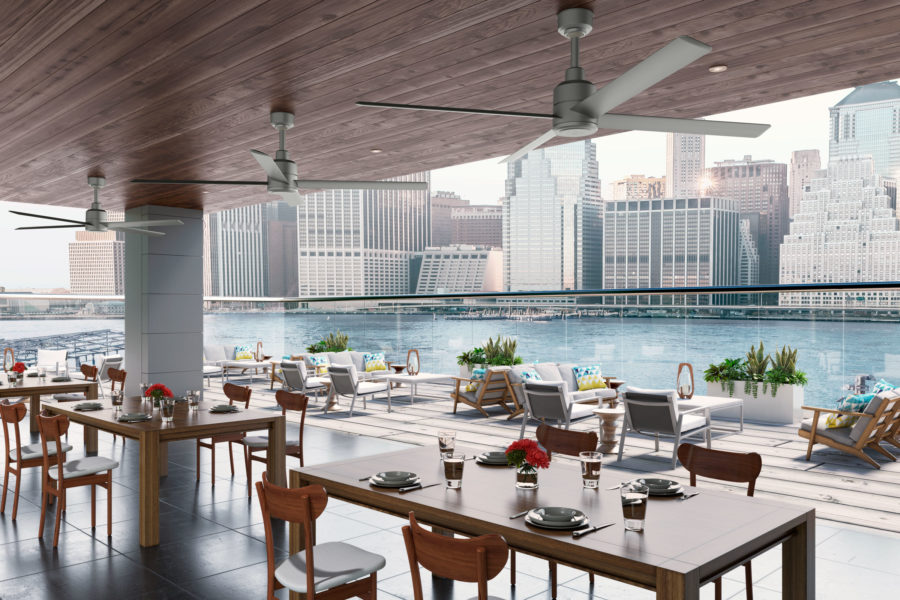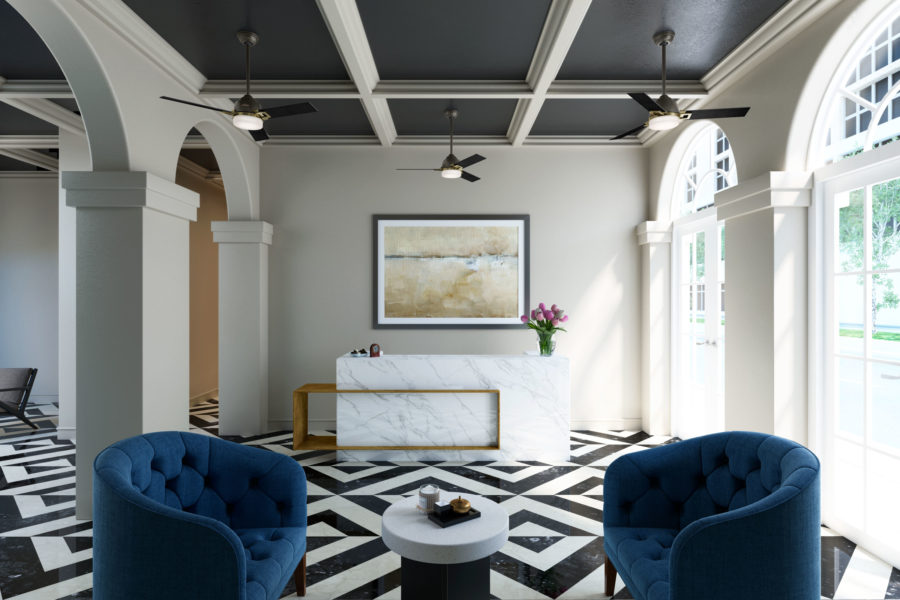Story at a glance:
- HVLS fans increase air circulation within large spaces, providing a number of health and wellness benefits to customers and employees.
- Hunter Industrial brings limitless design opportunities to commercial and industrial spaces by offering its full industrial, commercial, and residential catalog for any use case.
- New HVLS technology can further help customers reduce their energy consumption.
Architects and designers are always on the lookout for the statement piece that will pull their entire concept together—whether it’s a piece of furniture, a work of art, or even a practical appliance. “You generally wouldn’t think of ceiling fans as fixtures that tie the aesthetic of a space together, but they truly can make or break your overall design,” says Brianna Mello, product manager at Hunter Industrial, a division of Hunter Fan.
Ceiling fans and other air circulation devices are often an afterthought for the designers of industrial and commercial spaces. And yet a good designer understands the ways in which a fan can not only complement an aesthetic theme, but also serve critical functions that impact the health and well-being of the employees, customers, and others who occupy that space.
As the pioneer of the original ceiling fan back in 1886, Hunter Fan has long dominated the residential air circulation market. The company responded to a number of market forces by launching its Hunter Commercial unit two years ago and its Industrial unit six years ago, specializing in HVLS (high-volume, low-speed) fans.
The increased awareness of ways indoor air quality can have a dramatic impact on the health of employees and overall building health was a catalyst for Hunter Fan to dive into the industrial market.
Mello sat down with gb&d to discuss the ways HVLS fans act as a whole room design solution while also improving air quality and wellbeing.
What are the main benefits of HVLS fans?

Photo courtesy of Hunter Fan
Two of the most significant environmental improvements provided by HVLS fans are the cooling effect provided in warm weather months and destratification—the process of drawing down of warm, heated air that collects at the ceiling and bringing it down to where people are in cold weather months. The continuous mixing of air promotes a more uniform temperature throughout the facility, from floor to ceiling, while also lowering the concentration of harmful pathogens within the air.
This promotes a comfortable and healthier work environment by reducing absenteeism, employee complaints, and overall employee turnover. Air circulation from an HVLS fan can also help keep condensation from settling on the floor and on products, which can reduce moisture related issues within facilities.
There is also the substantial benefit of reduced energy consumption. HVLS fans move larger volumes of air while using less energy than high-speed fans or traditional HVAC systems, while also producing a less disruptive wind speed.
Now, not all HVLS fans are created equal. Hunter Industrial fans, for being as big as they are, are a lot lighter than you’d expect—about 20% lighter than a lot of other competitors. This means far less labor and time for installation, further reducing overhead costs for our customers.
What should architects consider before setting out to design a space?

Photo courtesy of Hunter Fan
I think the most critical question for architects and interior designers is: What will the occupants of the building—whether they are customers or employees—need in order to feel the most comfortable in this space? Those needs will be significantly different across residential, commercial, and industrial spaces. For example, if it’s a logistics warehouse with really high ceilings, they’ll need to move a lot of air, which tells us our Titan HVLS fans are what they need as opposed to smaller commercial solutions. The Titan blades range from 14 feet all the way to 24 feet in diameter.
For design professionals it’s important to understand the threshold of comfort that is desired based on the atmosphere that the end user is aiming for. This is really about finding the ideal marriage between aesthetics and performance.
For commercial spaces like restaurants where the overall ambiance is top of mind, you’ll probably be considering the aesthetics of the fan ahead of its air circulation benefits. For smaller areas like this our XP HVLS fans, the blades of which range from 7 to 14 feet, or our TRAK fans, whose blades are 5 to 8 feet, will be the ideal solution. On the other hand, industrial users want to prioritize function over form, as they need to ensure that the temperature and air quality in the space is conducive to employee health and productivity.
And then it’s also important to understand the power voltage that’s available, the size of the space, and to identify any potential interferences with the fans—are there beams or racks in the space that we need to worry about the fan having clearance?
What design opportunities do HVLS fans offer?
One of the best things about being a division of Hunter Fan is that we have access to their entire residential product portfolio, which is substantial. We’ve been around for more than 100 years, so whatever the aesthetic or design need for a commercial space is, we really have an answer for that.
If you’re designing a tropical restaurant along the shore, we have access to fans that would seamlessly fit with this design. If you’re remodeling a vintage warehouse into a loft office space, we have countless options that can fit a rustic, industrial aesthetic. We even offer chandelier fans.
By industry standards Hunter Industrial HVLS fans are some of the most aesthetically pleasing and user-friendly fans on the market. For instance, Hunter Industrial designed a capacitive touchscreen control that simplified the customer experience when compared to clunky wall controls of the past. They feature a sleek design that would be appropriate in a number of commercial applications where the performance of the fan is just as critical as appearance. Hunter Industrial was also the first company to develop a direct drive motor, which is smaller and quieter than the gearbox motors that are pretty standard in the HVLS market.
Although fans are often an afterthought, they really do have the ability to pull an entire space together through thoughtful and intentional design.
What new tech is Hunter Industrial incorporating in its lineup?
Over the last year we’ve really done a lot of work on the controls of our fans—for one, to streamline them and make them more functional for the customers, but also to make them sleeker and more aesthetically pleasing for a commercial experience.
One of the more exciting technologies is our environmental control system. You run into some customers who have specific parameters they want to keep their facility in at all times. Customers can easily program their controls to maintain a specific environmental temperature, and the fan automatically knows whether to speed up or slow down to achieve that cruise-set temp. That’s accomplished using both temperature and humidity sensors we place at the fan and control levels. And programming can be optimized between warmer and colder months simply by toggling between two modes.
The other thing we’ve incorporated is power-over-ethernet (POE) for our controls. This means there is one less connection for customers to worry about. All that is needed is a CAT-5 ethernet cord, and the HMI control powers right up. This translates into a quick and easy installation and allows for more flexibility of where customers can place their controllers since it does not need to be near an outlet.
How do these relate to Hunter Industrial’s sustainability goals?
Energy efficiency and overall operational costs are one of the most important topics we discuss with our customers. It’s no secret that excessive use of air conditioning is bad for your electricity bills and bad for the environment. And if you’re using HVAC alone to impact the temperature and the comfort of your facility, you’re going to be running it almost 24/7.
With HVAC systems, air settles where it settles if you don’t have anything in that space to move the air, and you have to pump four times as much cool or hot air into that space for comfort. HVLS fans circulate and mix that air and reduce the burden on your HVAC system, thus lowering your operating costs and carbon footprint.
Moving air consumes electricity and the combination of motor type and blade profile and pitch determine the energy required to move air, which is why we have an aerospace engineer designing the blades for our fans. On average, Hunter Industrial fans can reduce heating and air costs by 30%.


